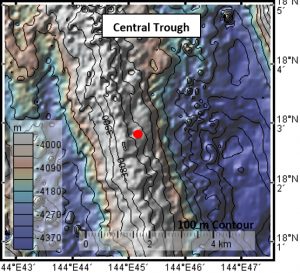
Central Trough Vent


Latitude: 18.047οN Longitude: 144.753οE Depth: 3680 m bsl
The Central Trough site is located in the Mariana back-arc basin near 18οN where the Mariana Trough is widest (Fryer, 1996; Hawkins et al., 1990). Estimated total opening rates for the BAB range from ~30 mm/yr (magnetic data) and to <43 mm/yr (dating basal sediments) (Martinez et al., 2000). Chimneys and ochreous oxide mud mounds are present. Hawkins et al. (1990) marked this as a high temperature (250οC-290οC) site. According to Alvin submersible dive 1832 in 1987 there are active sulfide-sulfate chimneys surrounded by low mounds of hydrothermal precipitates (Hawkins et al., 1990). Hawkins et al. (1990) further note this area is heavily colonized by gastropods, brachyuran crabs and anemones.
Note: Central Trough is the fourth site of the four vent sites described by Hessler et al., 1991.
Table 1: Operations history for Central trough vent
| Ship/ Platform | Operation | Year | Dive Number | References |
| R/V Atlantis II/ Alvin | Not found | 1987 Spring | 1832 | Hawkins et al., 1990 |
| R/V Folker (FK151121) | CTD, AUV Sentry | 2015 December | 368 | FK151121 cruise report |
Table 2: Vent activity and host rocks
| Activity and Host Rocks | References | |
| Activity | Active | InterRidge Vents Database Ver. 3.3 |
| Host Rocks | Basalt and minor Back-arc Basin Basalt | InterRidge Vents Database Ver. 3.3 |
Table 3: Vent fluid characteristics
| Vent Fluids | References | |
| Temperature (οC) | 290 οC | InterRidge Vents Database Ver. 3.3 |
| Full spreading rate (mm/yr) | 32.3 | InterRidge Vents Database Ver. 3.3 |
Table 4: Vent Biology
| General name | Phylum | References |
| Anemones | Cnidaria | Hawkins et al., 1990 |
| Brachyuran crabs | Arthropoda | Hawkins et al., 1990 |
| Gastropods | Mollusca | Hawkins et al., 1990 |
Images:
- Oxide sediment partly blanketing pillow lava side-slope of the axial ridge downslope from the mound shown in frame. Dive 1832, 3720 m (Hawkins et al., 1990).
- Top of a 10 m-high oxide mound, with delicate fingers of soft precipitate. Dive 1832, 3660 m (Hawkins et al., 1990).
- Active sulfide-sulfate chimneys surrounded by a low mound of hydrothermal precipitates, heavily colonized by gastropods, brachyuran crabs and anemones. Dive 1832, 3675 m (Hawkins et al., 1990).
Video Links: None known
References:
- Fryer, P, 1996. Evolution of the Mariana convergent plate margin system. Reviews of Geophysics 31 (1), 89-125.
- Hawkins, J. W., Lonsdale, P. F., Macdougall, J. D., Volpe, A. M., 1990. Petrology of the axial ridge of the Mariana Trough backarc spreading center. Earth and Planetary Science Letters 100, 226-250.
- Hessler, R. R., Lonsdale, P. F., 1991. Biogeography of Mariana Trough hydrothermal vent communities. Deep Sea Research 4 (2), 185-199.
- Martinez, F., Fryer, P., 2000. Geophysical characteristics of the southern Mariana Trough, 11ο50’N-13ο40’N. Journal of Geophysical Research 105 (B7), 16,591-16,607.
Website References:
- International cooperation in ridge-crest studies: InterRidge Vents Database Version 3; http://vents-data.interridge.org/ventfield/mariana-trough-unnamed (accessed 12/01/2015).
Website References:
- FK151121 – Hydrothermal Hunt on the Mariana Back-arc – R/V Falkor; https://schmidtocean.org/wp-content/uploads/FK151121-cruise-report-final.compressed.pdf (accessed 2/22/2017).

